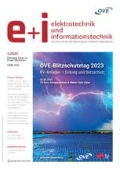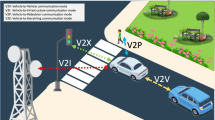Abstract
Standardization for wireless vehicular communication ensures, as in other domains, interoperability, supports regulations and legislation, and creates larger markets. For the initial deployment of vehicular communication, consistent sets of standards have been created, commonly named C-ITS in Europe and DSRC in the U.S., both relying on the WiFi standard IEEE 802.11. These initial standard sets specify vehicle-to-vehicle and vehicle-to-infrastructure communication and enable applications primarily for driver information and warnings. The article provides an overview of the key C-ITS and DSRC protocols from a standardization perspective. The article analyzes automated driving as the potential new application domain for vehicular communication, discusses its requirements on communication, and derives potential directions for future releases of the vehicular communication standards.
Zusammenfassung
Standardisierung für drahtlose Fahrzeugkommunikation ermöglicht, wie auf anderen Gebieten, Interoperabilität, unterstützt Regulierung und Gesetzgebung und schafft größere Märkte. Für die bevorstehende Einführung von Fahrzeugkommunikation wurden konsistente Standards entwickelt, und zwar für C-ITS in Europa und DSRC in den USA; beide Systeme basieren auf dem WLAN-Standard IEEE 802.11. Diese initialen Standards spezifizieren Fahrzeug-zu-Fahrzeug- und Fahrzeug-zu-Infrastruktur-Kommunikation und unterstützen hauptsächlich Anwendungen zur Fahrerinformation und -warnung. Dieser Artikel gibt einen Überblick über wichtige Kommunikationsprotokolle in C-ITS und DSRC aus einer Standardisierungsperspektive. Der Artikel analysiert automatisiertes Fahren als eine wichtige neue Anwendungsdomäne für Fahrzeugkommunikation, diskutiert die Anwendungsanforderungen an Kommunikation und leitet potentielle Richtungen für zukünftige Releases von Standards für Fahrzeugkommunikation ab.




Similar content being viewed by others
Notes
TMC delivers traffic and travel information via the FM broadcast radio.
EFC is another name for road user charging.
Communications Access for Land Mobiles.
Institute of Electrical and Electronics Engineers.
Society of Automotive Engineers.
Similar definitions from the German Federal Highway Research Institute (BASt) and the U.S. National Highway Traffic Safety Administration (NHTSA) exist.
Cooperative Advanced Cruise Control or Cooperative ACC.
Automatic Repeat reQuest.
Multiple Input-Multiple Output.
Single Carrier Frequency Division Multiple Access.
References
Kenney, J. B. (2011): Dedicated Short-Range Communications (DSRC) standards in the United States. Proc. IEEE, 99(7), 1162–1182.
Festag, A. (2014): Cooperative Intelligent Transport Systems (C-ITS) standards in Europe. IEEE Commun. Mag., 12(52), 166–172.
Car-2-Car Communication Consortium, http://www.car-2-car.org.
Amsterdam Group, http://www.amsterdamgroup.eu.
Harrer, M., et al. (2015): From research and living lab to implementation of C-ITS. e&i, Elektrotech. Inf.tech. 132(7).
Institute of Electrical Engineers (2011): IEEE standard for information technology—telecommunications and information exchange between systems—local and metropolitan area networks—specific requirements, part 11: wireless LAN medium access control (MAC) and physical layer (PHY) specifications, March 2012, http://ieeexplore.ieee.org/servlet/opac?punumber=6178209.
Mecklenbräuker, C. F., et al. (2011): Vehicular channel characterization and its implications for wireless system design and performance. Proc. IEEE, 99(7), 1189–1212.
Tielert, T., et al. (2011): Design, methodology and evaluation of rate adaptation based congestion control for vehicle safety communications. In Proceedings of IEEE vehicular networking conference (VNC), Amsterdam, Netherlands, November 2011 (pp. 116–123).
ETSI (2014): Intelligent Transport Systems (ITS); vehicular communications; basic set of applications; part 2: specification of cooperative awareness basic service, EN 302 637-2, November 2014.
ETSI (2014): Intelligent Transport Systems (ITS); vehicular communications; basic set of applications; part 3: specifications of decentralized environmental notification basic service, EN 302 637-3, November 2014.
SAE International (2014): Taxonomy and definitions for terms related to on-road motor vehicle automated driving systems, SAE J3016, January 2014, http://standards.sae.org.
Prasad, A., et al. (2014): Energy-efficient D2D discovery for proximity services in 3GPP LTE-advanced networks: ProSe discovery mechanisms. IEEE Veh. Technol. Mag., 9(4), 40–50.
Next Generation Mobile Networks (NGMN) alliance (2015): NGNM 5G white paper, NGNM 5G initiative, February 2015, 124 p., http://www.ngmn.de/uploads/media/NGMN_5G_White_Paper_V1_0_01.pdf.
5G Infrastructure Public Private Partnership (5G-PPP) (2015): 5G automotive vision, 65 p. (in press), https://5g-ppp.eu/, September 2015.
Amsterdam group (2013): Roadmap between automotive industry and infrastructure organisations on initial deployment of Cooperative ITS in Europe, version 1.0, https://amsterdamgroup.mett.nl. June 2013.
Acknowledgements
This work was supported by the German Science Foundation (DFG) within the priority program “Kooperativ interagierende Automobile” (SPP 1835).
Author information
Authors and Affiliations
Corresponding author
Rights and permissions
About this article
Cite this article
Festag, A. Standards for vehicular communication—from IEEE 802.11p to 5G. Elektrotech. Inftech. 132, 409–416 (2015). https://doi.org/10.1007/s00502-015-0343-0
Received:
Accepted:
Published:
Issue Date:
DOI: https://doi.org/10.1007/s00502-015-0343-0




